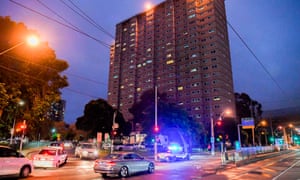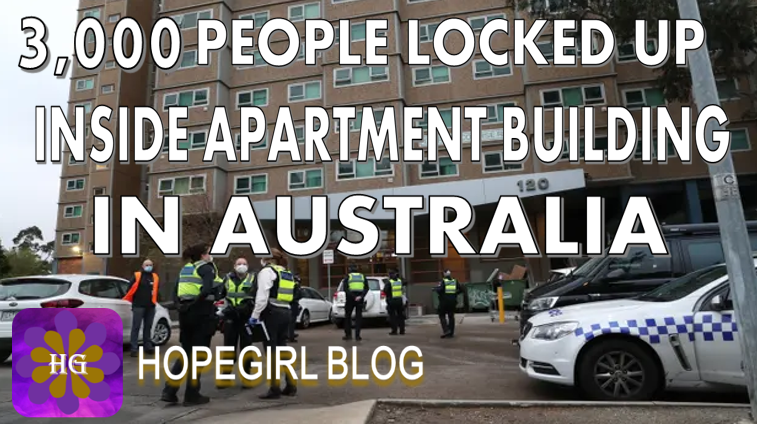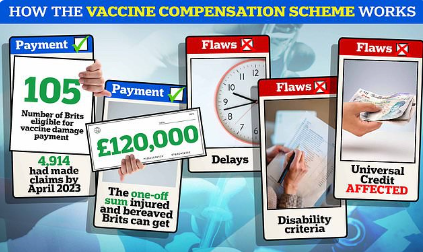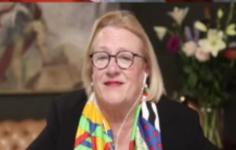No one in or out, not even for groceries. No, this ISN’T China, its in the western, English speaking country of Australia. 3,000 People have been placed under the harshest lockdown so far.
Three thousand people living in nine public housing towers in Melbourne have been placed under the harshest lockdown rules of the coronavirus pandemic in Australia so far and banned from leaving their homes for at least five days.
The Victorian government’s decision to lock down all nine towers was made because of “patterns of movement, friendship groups, family groups,” the premier said.
Daniel Andrews also cited the crowded living in public housing and many communal spaces, meaning community transmission was high risk.
Five hundred police officers have been dispatched to monitor the nine towers in Flemington and North Melbourne and ensure that the residents do not leave their small and often overcrowded units.
Residents living in the flats are among the most vulnerable and heavily policed people in the state of Victoria, with a high population of new migrants, Indigenous people, people experiencing severe mental illness and people who have experienced family violence or homelessness.
Residents told Guardian Australia they felt “singled out” by the lockdown order, which was implemented with no warning at 4pm, and “intimidated” by the large police presence.
Andrews, announced the “hard lockdown” of the nine towers late on Saturday, at the same time as he announced that two new postcodes – 3031 and 3051, taking in Flemington, Kensington, North Melbourne, and Hotham Hill – would be placed under stage-three stay-at-home orders from midnight.
The difference between the more than 300,000 people in Melbourne under the stage-three orders, and the nine towersis that those under stay-at-home orders can leave their homes to exercise, do grocery shopping, conduct essential caregiving and attend work or study if they cannot do so remotely.
Those living in the towers cannot.
“If you’re in one of those towers the minister has just read out, you will not be allowed to leave your unit, your dwelling within that tower, for any reason,” Andrews said.
He said the lockdown would be in place for at least five days, because that was how long health officials estimated it would take to test every single resident in those units, and get the test results back. But the lockdown could last 14 days, he said.
There are more than 1,300 units in the nine towers. Residents were not forewarned before the premier made the announcement and police arrived at their door. Andrews said the state government would be arranging for food, healthcare and other essential services to be delivered to the residents, but the details of how that will work have not been announced or discussed with residents.
The housing minister, Richard Wynne, said people living in these public housing towers were “some of the most vulnerable people in our community”.
“Many of them are subject to co-morbidities and we want to ensure that we wrap around them all of the services that they are going to need, not just over the next five days or indeed potentially the next 14 days, but going forward that we provide them with all of the support they need to maintain their tenancy but obviously to maintain their wellness also,” Wynne said.
But no social workers or other support services were observed outside the tower blocks in Flemington on Saturday night – only armed police officers wearing gloves and face masks.
Hana, who shares a three-bedroom flat in one of the Racecourse Road towers with her mother and sister, said she had returned from grocery shopping just after 4pm to be met by an “intimidating” police presence.
“I was just shocked,” she said. “I thought, I don’t know, it seemed like there was some criminal activity or something, like a stabbing or something … I asked, ‘What’s happened?’ and they said, ‘Oh, there’s an outbreak. You can’t leave your house. Just park your car, you can’t leave your house.’”
Hana said it was unfair that the public housing blocks had been locked down when other large apartment buildings in the area had not, and also unfair that they had not been given any warning.
“You had other suburbs where they had 48 hours warning before they were put in lockdown,” she said. “How come we are any different? It just feels like we have been singled out.”
Another woman, who lives in the tower block at 129 Racecourse Road, Flemington, said she had received a text message while she was at the supermarket telling her not to leave her home.

She said she was concerned for her grandmother, who lives in a neighbouring block and requires visits from carers several times a day.
“I’m actually a bit worried about my gran because she has carers coming to feed her daily … and I don’t know what’s going to happen with the carers now and who’s going to be feeding my grandma,” she said. “So I am hoping they have got that organised … she needs to be fed today.”
She said she had expected the tower to be locked down “at some point”.
Most people living there had been trying to self-isolate, she said, but with shared amenities that was impossible.
“It’s still down to the elevators, which are shared, our laundry, which is shared, and even where put our rubbish, there’s a handle that we all have to keep touching to lift,” she said.
“So it was going to go around the flats … I am glad that we’re trying to limit it as much as possible but … I am not sure how they are going to handle this because this is the first time it happens here. Are we going to go through this every three or four weeks? Because that’s going to drive us insane.”
Australia’s acting chief medical officer, Prof Paul Kelly, said the public housing lockdown was “unprecedented”. Both he and Andrews compared it to the lockdown of an aged care home once an outbreak had been detected.
Kelly said while these steps are unprecedented, given the vulnerability of many people living in the towers, to do anything else would be contrary to public health advice.
“[That would] pose an unacceptable risk to the health and wellbeing of those who live in the towers and, by extension, the health and wellbeing of every single Victorian,” he said.
The extension of the lockdown to 12 postcodes from 10 was made on the back of Victoria recording 108 new cases of Covid-19 in 24 hours, the highest single-day increase in the state’s figures since the national daily incidence peak on 28 March.
Those new cases include 23 people who live in the nine public housing towers but Victoria’s deputy chief medical officer, Dr Annaliese van Diemen, said there were “hundreds” of high-risk close contacts spread across the towers. If they were not locked down, she said, it would risk an “explosion” of new cases among vulnerable people living in housing estates.
Nationally, Australia recorded 113 new coronavirus cases in 24 hours. New South Wales reported five cases in hotel quarantine, and added 189 historical cases – mainly crew members of the Ruby Princess cruise ship – to its tally for the purpose of the World Health Organization’s accounting.
Learn about EMF Protection
http://ftwproject.com/special-offers

Get our Book Forbidden Tech
https://www.forbiddentech.website/














